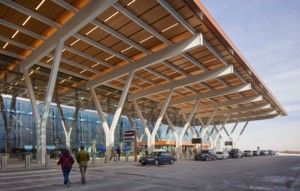The tenants for Governors Island’s new climate-focused hub have been chosen. The campus will serve a consortium led by Long Island’s Stony Brook University: the newly-formed nonprofitNew York Climate Exchange, a partnership between the school and core partners including Boston Consulting Group, the Georgia Institute of Technology, Pace University, Pratt Institute, the University of Washington, IBM, and the housing and preservation group Good Old Lower East Side (GOLES).
Last fall, four finalist teams wereannounced for the hub, whose goal is to “research and showcasing how cities around the world can equitably adapt toclimate change.”

The proposed campus, to be designed by Skidmore, Owings, and Merrill (SOM), will span 400,000 square feet on the east side of the island. It will be built at a cost of $700 million, creating 2,200 union jobs. The campus will be home to “600 postsecondary students, 4,500 K-12 students, 6,000 workforce trainees, and 250 faculty and researchers… while supporting up to 30 businesses annually through its incubator program,” Mayor Eric Adams’ office said in a press release.
The mayor described the plan as a “giant leap toward a cleaner, greener, more prosperous future for every New Yorker.” It comes just a few days after the cityreleasedits updated climate response plan.

While it had been previously announced that the city, along with theTrust for Governors Island, a city-created nonprofit, would release up to $150 million in funding for the project. Today’s announcement included a $100 million gift from the Simon Foundation and $50 million gift from Bloomberg Philanthropies. The $550 million funding gap is planned to be filled through the Exchange’s own fundraising efforts.
SOM design partner Colin Koop said that the “new campus embodies the stewardship necessary to solve the climate crisis by weaving sinuousmass timberpavilions through the rolling landscape of the park and reusing the historic building fabric of Governors Island.” Working alongside SOM to develop the campus are Mathews Nielsen Landscape Architects, Buro Happold, and Langan Engineering.
Stony Brook University President Maurie McInnis argued for the necessity of the campus, saying that: “Up until now, the development of climate solutions has been siloed, with world leaders separate from expert scientists separate from the on-the-ground green workforce.” This will take place on a campus that will include “green-designed building space, including research labs, classroom space, exhibits, greenhouses, mitigation technologies, and housing facilities,” according to SOM.

Construction is set to begin in 2025, with its opening targeted for 2028. According to the Mayor’s office, afuture second phase of the project could see the renovation of the island’s historic Liggett Hall and the development of three additional acres on the east side. Given the expected increase in traffic, the Trust will increase ferry frequency to 15-minute headways beginning Summer 2024. The campus will be anchored by two ground-up classroom and research buildings whose design was abstracted from the island’s hills.
In-line with the Exchange’s mission, campus buildings will run entirely on electricity from on-site solar power generation, with the potential for net-positive energy which could fuel the local grid. Furthermore, all non-potable water will be supplied from rainwater or treated wastewater, and 95 percent of waste will be diverted from landfills.















